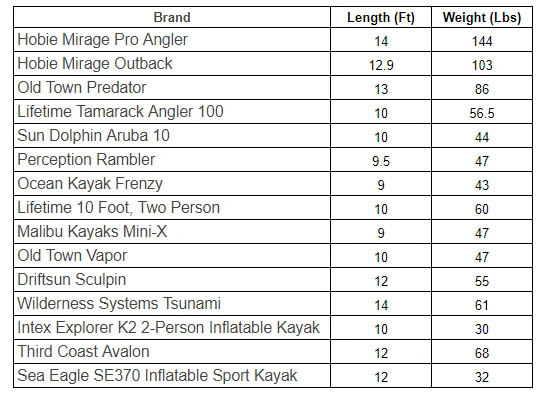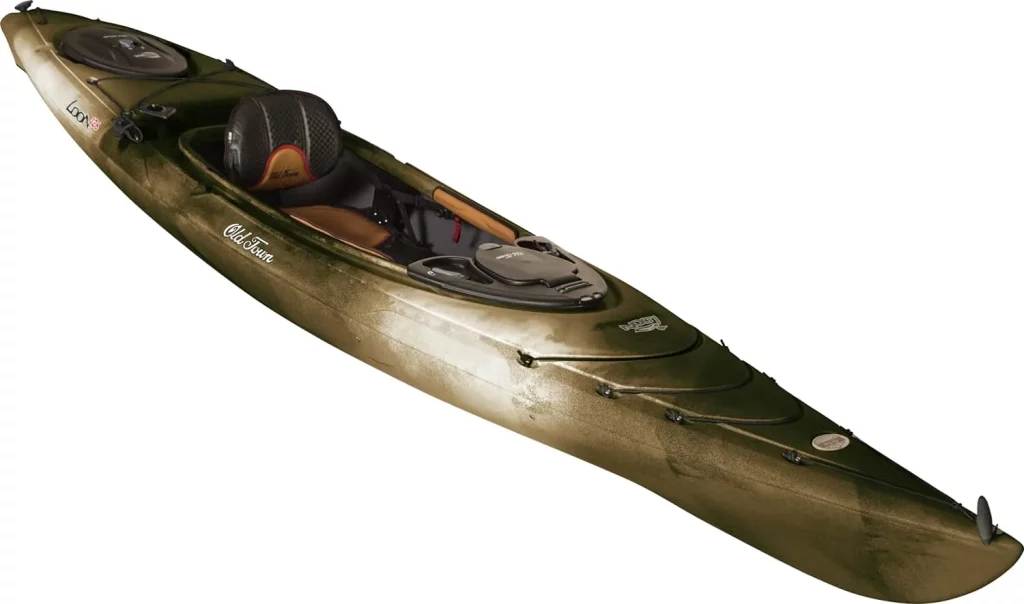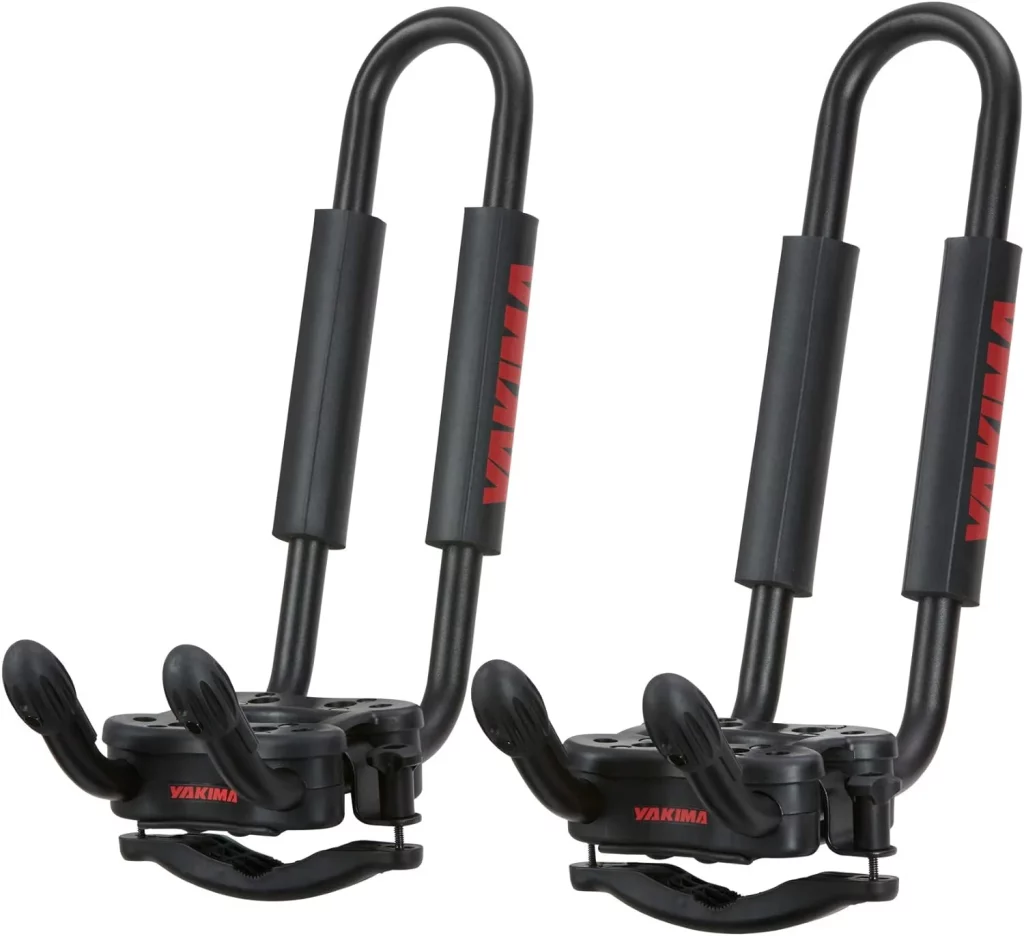What Is the Best Kayak Weight Limit? ( Average 56.5)
You undoubtedly already know that there is a wide range of kayak sizes available if you’re in the market for one, whether for fishing or exploration. The length and kind of kayak you choose will have the most impact on how much the kayak weight.
Having said that, a typical kayak weight about 65 pounds. But kayaks might be as light as 32 pounds or as heavy as 144 pounds.

I have made an effort to produce a list of 15 of the most popular kayaks on the market today to give you a better understanding of how much the various kinds of kayak weight. I have measured their lengths and widths, as well as kayak weight.

Contents
- 1 Why should you care? How Much a Kayak Weight
- 2 Does a kayak’s weight change with its length?
- 3 Can a Heavy Person Use a Kayak Lightweight?
- 4 Are Inflatable Kayaks more Portable than Hardshell Kayaks?
- 5 How Does the Weight of Kayak Compare to a Canoe?
- 6 Best Way to Transport a Weight of Kayak
- 7 Conclusion
Why should you care? How Much a Kayak Weight
When shopping for a kayak, portability is crucial, so keep the kayak weight in mind.
If you buy a kayak that weighs too much, then you may have difficulty carrying it, particularly if you like to go kayaking by yourself.
I made this error when I moved from my 70-pound Ascend FS12T fishing kayak to the bigger Old Town Predator 13, whose kayak weight was 86 pounds.
The difference of 16 pounds may not seem like much, but it will be when you’re trying to hoist your kayak onto the roof of your vehicle all by yourself.
The burden of your kayak’s mass could be lessened if you access a vehicle or kayak trailer.
If you normally go kayaking with a friend, this may not be an issue either. Two people can readily lift most kayaks.
Does a kayak’s weight change with its length?
Yes. I have yet to encounter a kayak where the length didn’t affect the load.
In reality, if you take two identical kayaks (other than their lengths) and compare their weights, you’ll discover that the longer, broader kayak will weigh more.
It makes perfect sense if you think about it. A longer kayak requires more materials. Thus, it makes sense that it would be heavier.
Keep in mind that a longer kayak’s weight distribution is not as symmetrical as that of a shorter one.
At first glance, this may not seem like a big deal, but when you attempt to raise it on your own, you find it is.
In my opinion, 12 feet is the perfect length for a kayak. A kayak of this length is manageable by most people, has enough inside space for most, and tracks well on the water. Paddling a shorter kayak is more challenging since it moves less efficiently.
Can a Heavy Person Use a Kayak Lightweight?
The answer is yes! The Old Town Vapor (one of the lightest kayaks on our list at 47 pounds) can support up to 325 lbs.
My brother-in-law owns this same kayak, and he is 6’0 and, I would guess, weighs approximately 240.
That said, it may not be the coziest or most useful ride!
A smaller kayak should be enough for a leisurely cruise around the lake.
However, you may want to upgrade to a larger model if you use it for fishing. A kayak that can carry your body weight and has appropriate storage space for your stuff is essential.
The problem is that smaller kayaks tend to be lighter. This pertains to both their dimensions in length and breadth.
Are Inflatable Kayaks more Portable than Hardshell Kayaks?
When compared to their hardshell counterparts, inflatable kayaks do have a weight advantage. However, they are not that much lighter!
Inflatable kayaks, when compared in length to their hardshell counterparts, are typically 10–20 pounds lighter.
Although this is a lot of kayak weight, does it make sense to choose an inflatable over a hardshell? I think not!
Hardshell kayaks are far more stable than inflatable kayaks, making them a superior overall option.
I’ve also discovered that although the most weight of hardshell kayak around 65 pounds, some come in at around 50 pounds.
Putting a kayak that weighs fifty pounds on your car’s roof should be easy for the average person to manage.
How Does the Weight of Kayak Compare to a Canoe?
A canoe of comparable length and weight is roughly the same as a kayak. The Saranac 14-foot canoe sold in Old Town, for instance, weighs 79 pounds and can hold up to 750 pounds.
In comparison, Old Town’s Predator 13-foot kayak comes in at 86 pounds but only has a top capacity of 425 pounds.
Even though their respective kayak weights are comparable, the canoe has a greater carrying capacity than the kayak.
After much study, I concluded that when comparing a kayak and a canoe of the same length, the canoe often has a higher load capacity.
Best Way to Transport a Weight of Kayak
No worries if you have a vehicle or, even better, a kayak trailer. Just throw some straps over it and pack it up.
If you’re traveling with a vehicle or SUV but no trailer, you’ll need to devise another strategy.
Unless your vehicle or SUV currently has one, this will likely need the purchase and installation of a roof rack.
There are hundreds of roof racks to choose from, so finding one that works with your vehicle and is within your price range shouldn’t be difficult.
For now, you could even use pool noodles as your roof rack, as I did when I brought my kayak home from the sports goods shop.
You’ll want the great, thick ones instead of the cheap ones at the Dollar Store! To safely transport the noodles and kayak, you’ll need at least four tie-down straps.
Although this would work, I would advocate something other than your go-to technique of carrying the weight of a kayak. To get away with it, your kayak must weigh less than 50 pounds.
A universal soft roof rack pad system is something else you may look into!
Since I spend a lot of time kayak fishing in saltwater, the metal roof rack I originally bought for my vehicle eroded over time from the constant drip of seawater. As a result of this, I decided to purchase the Yakima Easy Top Instant Roof Rack.
It fits most cars and has a maximum weight capacity of 80 pounds, and setting it up is a breeze (it took me less than 10 minutes to figure out and install). And best of all (at least for me), it doesn’t rust!
And unlike a metal roof rack, this one won’t break the bank!
Conclusion
I know it’s hard to take a step back occasionally and rethink things, particularly after you’ve already spent time researching and decided on the right kayak weight.
However, knowing the weight of a kayak is crucial before making a purchase. You want to spend less than hundreds of dollars on a kayak only to realize it’s too heavy when you get it home.
It’s also recommended that you physically hold the kayak before purchasing it to get a feel for how it feels in your hands and determine whether it’s the right size for you.



